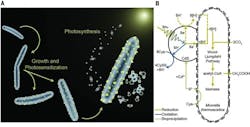Better Bioprocess for Acetic Acid Beckons
Precipitating nanoparticles of a semiconductor on a bacterium that does not normally engage in photosynthesis enables the organism to use light to reduce carbon dioxide to acetic acid at high yields, report researchers in California. The semiconductor, cadmium sulfide (CdS), acts as a light harvester, spurring photosynthesis.
The process combines the highly efficient light harvesting of inorganic semiconductors with the high specificity and low cost of biocatalysts, say Kelsey Sakimoto, Andrew Wong and Peidong Yang, all of whom are in the Department of Chemistry at the University of California – Berkeley and in the Materials Science Division of the Lawrence Berkeley National Laboratory, both in Berkeley, Calif.
Figure 1. Deposition of cadmium sulfide enables bacterium to use light to reduce carbon dioxide to acetate. Source: University of California – Berkeley.
The photosynthesis of carbon dioxide to acetic acid by the bacterium, M. thermoacetica, and CdS involves two steps in a single pot (Figure 1), they explain. First, growing the bacterium in the presence of cadmium and cysteine triggers the precipitation of the CdS nanoparticles. Then, the bacterium uses electrons generated by illuminated CdS nanoparticles to perform the photosynthesis. The calculated yield of acetic acid is about 90%. More details appear in a recent article in Science.
The hybrid system, the researchers believe, offers advantages, such as the ability to tune the effective light flux per bacterium, over natural photosynthesis, and also promises improved efficiencies compared to traditional biological approaches to nanoparticle synthesis that use ligands.
At this point, the development is at the proof-of-concept stage.
“There are a couple of things we are doing as the next step. We are attempting to include water oxidation, the other part of the half reaction of the photosynthesis. We are also looking into the fundamental electron charge transfer at the semiconductor/bacteria interface,” notes Yang.
Key challenges remain to be addressed, he admits. “There are many — decorating the bacteria with [a] less-toxic semiconductor with better light absorption; completing the other half part of the photosynthesis; and understanding the fundamental electron transfer across the semiconductor/bacteria interface.”
However, Yang is optimistic that the hybrid system ultimately might serve for commercial production of acetic acid.

